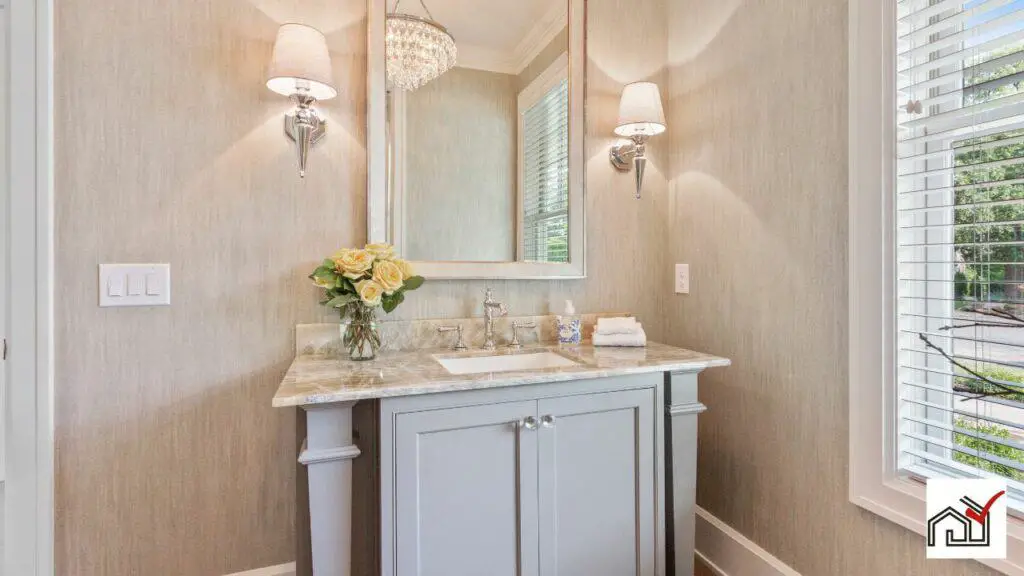The ideal vanity drain height typically ranges from 18 to 20 inches from the floor. This standard height ensures the correct installation of the P-trap and helps in efficient drainage. It also provides sufficient space for your hot and cold water supply lines.
However, the ideal height of the vanity drain may vary depending on the depth and type of your sink and the height of the countertop.
For instance, a shallow sink may need a higher drain height, while a deep sink may need a lower height. If you’re tall, a higher countertop and drain height may be more comfortable for you.
When installing your vanity, consider these factors to create a functional bathroom space.
Factors Affecting Vanity Drain Height
The factors that significantly impact the height of your vanity drain are the depth and style of your sink and the rough-in height of your sink.
Sink Depth and Type
The depth of a standard sink usually varies from 8 to 12 inches.
If you opt for a deeper sink in your bathroom, you will need to alter the drain’s rough-in height, which typically lies between 18 to 20 inches above the floor.
Other elements like the vanity top height and trap height can also influence this measurement.
Sink Rough-in Height
The rough-in height for a bathroom sink is usually between 18 and 20 inches from the floor.
This height is important for the correct positioning of the P-trap and to accommodate the hot and cold water lines.
The precise rough-in height can vary based on the height of your countertop and the depth of your sink.
So these factors must be considered when deciding on the ideal vanity drain height. Doing so will ensure your sink installs correctly and functions efficiently.
How to Measure Vanity Drain Height?
Let’s now talk about how to measure the vanity drain height. It begins with the measurement from the base floor.
We’ll also discuss the significance of precise drain pipe placement and its impact on your overall installation.
Measuring from The Base Floor
Measuring from the base floor can enhance the precision of your vanity drain height calculation.
This technique provides a stable reference point, irrespective of the condition of your bathroom’s construction.
Remember to factor in the thickness of the finished floor if you’re working on a new build.
On the other hand, for a remodel, you may need to reduce a few inches from the usual 18 to 20-inch rough-in height to account for differences due to the existing flooring.
The base floor measurement assures the exact positioning of your P-trap and sufficient space for your hot and cold water lines, leading to a more effective drainage system.
Drain Pipe Placement

The position of the drain pipe is critical in setting the correct height for the vanity drain.
The drain pipe serves as the vertical centerline for the sink drain height. It should be placed 16 to 20 inches above the base or sub-floor level.
Correct positioning of the drain pipe allows it to line up with the bathroom sink and sit between the water supply lines. This alignment ensures the sink drains efficiently and functions properly.
Fixture Measurements
Fixture measurements are important for correctly setting the height of a vanity drain. They help establish suitable gaps and clearances for the sink installation and the plumbing system’s optimal operation.
For bathroom sinks, there should be a minimum clearance of 15 to 18 inches from the finished sidewall, sink, or any other object. This space ensures enough room for the sink and its surroundings.
The front clearance should be at least 21 inches, but 30 inches is preferable. This space allows for easy use of the sink and eliminates obstructions.
What Are Common Issues and Solutions Related to Vanity Drain Height?
Let’s now look at the common problems associated with vanity drain height and discuss some practical solutions to fix your vanity plumbing.
P-Trap and Drainage Problems
Improper P-trap installation can lead to significant drainage issues. So it’s crucial to ensure it’s installed correctly.
If the height of your sink drain doesn’t fall within the standard rough-in range of 18 to 20 inches, it can lead to problems. You could also potentially fail the required inspection and need to restart the entire construction process.
To prevent these issues, make sure the rough-in height of your sink drain is correct. This ensures the P-trap is correctly placed for efficient drainage and leaves enough space for your hot and cold water lines.
Adjusting Drain Height for Deeper Sinks
If you’re fitting a deeper sink, it’s important to modify the drain height for effective drainage and sufficient space for the P-trap.
If the drain is too high, the sink might not drain properly, resulting in slow drainage or stagnant water. Conversely, a too-low drain might not accommodate the P-trap, leading to leaks or blockages.
To prevent these issues, measure your new sink’s depth and adjust the drain height accordingly. Also, ensure the drain is level for proper alignment, and remember to allocate sufficient space for the P-trap.
P-Trap Is Too Low for Vanity
If your P-trap is too low for your bathroom fixture, there are several solutions.
You can cut a notch in the vanity to make room for the P-trap. You can also consider using a sink drain extension to increase the P-trap’s height, which will allow it to connect with your vanity.
Another option is to open the wall and elevate the drain pipe. This requires more effort but may solve your issue.
You could also lower the vanity to match the P-trap’s height.





